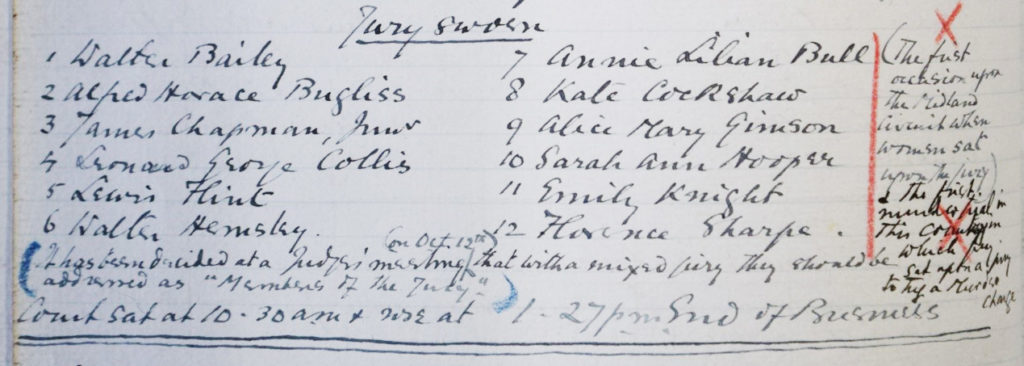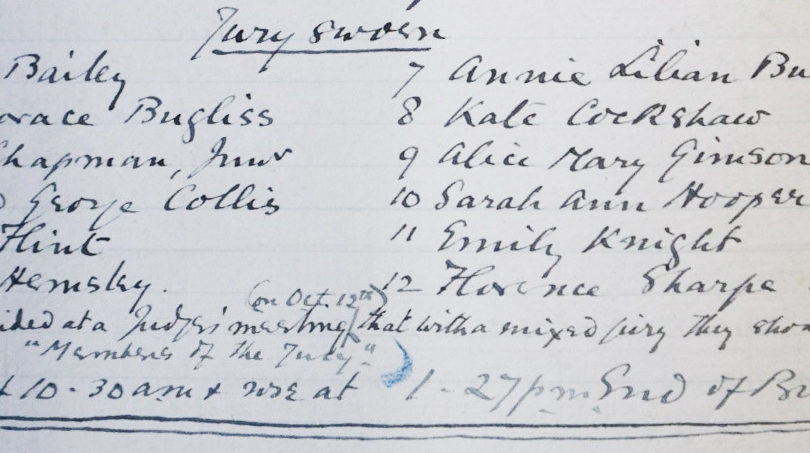In my article in the Law and History Review, I chart a series of reforms to the rules used for identifying people qualified as jurors in England and Wales during the 1920s. The Sex Disqualification (Removal) Act of 1919 ended restrictions on women acting as lawyers, as judges, and as jurors, and so, as the 1920s began the juror franchise had been radically altered. But why explore reforms immediately after 1919, when any such reforms were unlikely to change things as dramatically as the decision to extend the juror franchise to include women?
What we can see by exploring two successful reforms to the jury franchise during the five years after 1919 is how jury service became a prism through which the nature of citizenship, and indeed of legitimate governance, could be contested. One way in which this manifested was in the relationship between local, customary rules of governance on the one hand, and national, codified rules on the other. This was an old problem, but it was one which the judiciary suddenly became much more interested in resolving with the advent of women jurors.
When the rules for identifying those people who were qualified as jurors were codified in 1825, a somewhat enigmatic provision had explained that the rules would not apply to those towns that ‘possessed’ their own courts. This was read at the time – and for almost a century afterwards – as meaning that independent borough courts did not need to observe rules requiring jurors to possess a certain amount of landed property. While the details of how all this worked out are a little complex (a complexity which is explored in detail in my LHR article), the basic point is that by 1919 ten towns considered themselves free to ignore the property qualifications if they chose to, and that their reading of the 1825 Act was well known and uncontroversial.
This all changed once women were able to qualify as jurors, when it suddenly became important that this species of variable local custom must be subordinated to consistent national rules. This is not a change that existed in a vacuum of course, and to the extent that jury service was regarded as a function of citizenship it is worth noting that some scholars have traced a similar trend in citizenship more generally. Just as the Victorian tradition of a citizenship idea rooted in local government was being replaced by a nationalized concept focused on simple and clearly promulgated rules, the well-established notion that different places might identify and summon their jurors in different ways was also coming under attack.

And it is worth briefly pausing to note that the idea of local variations was not merely hypothetical. Once women were no longer prohibited from serving as jurors, the ten independent towns immediately acted very differently. In the Midlands, they regularly achieved juries of 6 men and 6 women, while their southern equivalents retained their all-male juries. But it was not this divergence which led to the attack on their autonomy, as objections to their independence came before they had had any opportunity to implement the 1919 reforms adding women to their jury pools.
Early in 1920, a judge told officials at Exeter and Bristol that their practice of ignoring the property qualifications was illegal. Bristol complained to the Home Office, and a lengthy internal debate ensued about the precise nature of the exemption under the 1825 Act, as well as any consequences for the women newly qualified as jurors if this exemption was abolished. The judiciary’s concern was that a lack of consistency could result in women never being selected for jury service, while for the Home Office any decision to extend the property qualifications to these towns would disqualify many more women than men. When the judiciary got their way, the undersheriff of Newcastle upon Tyne wrote to complain that “the proportion of Women to be empanelled [would] be considerably less” following these reforms, passed almost exactly twelve months after the 1919 Act.
These reforms brought with them their own difficulties. The ten previously independent towns had never been required to prepare lists of qualified jurors, and asking them to do so at a time of severe paper shortages and a time of austerity was politically untenable. Furthermore, those places that had traditionally been required to prepare juror lists had been temporarily allowed to use old lists to save on printing costs. This created a problem: how to gather together lists of qualified jurors without incurring the cost of printing such lists? The solution was to simply amend the electoral registers, adding a ‘J’ to the name of any person qualified for jury service.
This second reform, on the face of it, had the added advantage of confirming that jury service, voting, and citizenship are all deeply connected. But this was not the motivation; electoral registers were adopted as the basis of juror qualification to save money. And because electoral registration carried with it a very particular set of citizenship-based assumptions, these assumptions were imported into the jury franchise. This reform certainly brought jury service, voting, and citizenship closer together, but it did so in predominantly restrictive ways.
For one thing, the kind of citizenship reflected in electoral registration was one grounded in ideas of service. After the First World War, servicemen who were not yet twenty-one were temporarily given the franchise, despite twenty-one being the ordinary minimum age for men to vote. Equally, those people who had registered as conscientious objectors were temporarily denied the parliamentary franchise. And of course foreigners were not entitled to vote, but legislation passed in 1870 had permitted them to serve on juries once they had lived in England and Wales for ten years or more. Now that jury service was based on electoral registration, these generally restrictive attitudes to citizenship were imported into the jury. This reform also represented a second restriction on the newly enfranchised women jurors: now, if a woman owned property in one area but lived elsewhere with a male relative, she would not longer be qualified, as she failed to satisfy both main qualifications simultaneously.
Perhaps the most striking thing about the various changes to the juror franchise in the years immediately after 1919 is just how unknown they are. For major changes that helped reshape the relationship between the center and the periphery in the administration of criminal justice, and that helped reshape the practical meanings of citizenship in the interwar period, it is remarkable that these reforms are not better known. This, however, is no accident. While there were lengthy debates about the reforms within government (both local and national), great care was taken to prevent all this from becoming a well-publicized political issue. When the ten independent towns had their discretion abolished, for example, the Lord Chancellor prevented meaningful parliamentary scrutiny by presenting his Bill as a response to an administrative emergency. As an emergency, it had to be dealt with quickly, and as a mere administrative matter, it was unlikely to attract very much political comment.
But despite these attempts to take the heat out of these reforms (and it is known that various MPs were in fact quite concerned), their significance remains. By subordinating variable local custom to uniform national rules, and by restricting jury service to those who were registered to vote, it is clear that reform made the jury franchise more restrictive in the years immediately after the lifting of the blanket ban of women jurors.



 Their article, “Restricting the Juror Franchise in 1920s England and Wales,” appears in Law and History Review 37 no. 1 (March, 2019).
Their article, “Restricting the Juror Franchise in 1920s England and Wales,” appears in Law and History Review 37 no. 1 (March, 2019).